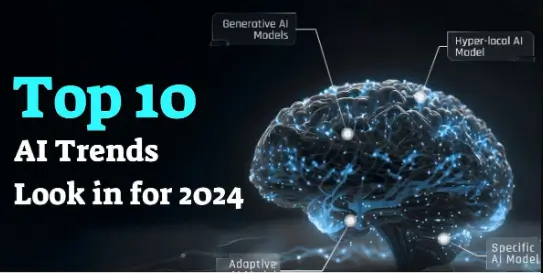Top 10 Data & AI Trends for 2024 are mentioned here.
Don’t Get Swept Away: Navigating the 2024 Data & AI Tidal Wave
Hold onto your data hats, folks! The exciting, tumultuous world of data and AI is surging once again. 2023 was all about the buzz around generative AI (GenAI), but 2024 promises to be different. It’s time to move beyond name-dropping and dive into real-world applications.
GenAI, like a rising tide, lifts all ships in the data ecosystem. As it evolves, so too will our priorities and standards.
Read More: ReactNative New vs. Old Architecture: Comparison
Here are 10 predictions to help your team stay afloat:
1. LLMs Reshape the Data Landscape:
Big language models (LLMs) are no passing fad. They’ll continue reshaping how we handle data, driving a surge in demand and even necessitating new infrastructure like vector databases. Think of it as a complete overhaul of the “AI stack.” But beyond the tech, the real question is: are we using these LLMs to solve actual problems and deliver genuine value? Let’s focus on substance, not just flashy PR stunts.
2. Data as the New Product Champion:
Imagine data, not just analyzed, but meticulously crafted and packaged like a premium wine. That’s where data teams are heading. With product requirements, documentation, and even end-user SLAs, these teams are treating their data as the gold it truly is. This shift means better data management, clearer insights, and most importantly, tangible value delivered.
3. Software & Data: A Marriage of Minds:
The days of silos are over. In 2024, software engineers and data wizards will be dancing tango. Every major software development will have an AI eye, fueled by real-world data. And conversely, no groundbreaking AI will emerge without the muscle of enterprise data behind it. This means engineers will need to develop a data-savvy sixth sense, understanding how to work with it to build truly valuable AI products.
4. RAG: The Secret Weapon in the GenAI Arsenal:
Remember those embarrassing GenAI blunders? Turns out, the key to flawless AI is not just massive datasets, but clean, reliable data with context. That’s where RAG (retrieval-augmented generation) enters the scene. Imagine fine-tuning your AI with high-quality, proprietary data, giving it a unique edge and a deeper understanding of your specific world. This is RAG’s superpower, and organizations are rushing to unlock its potential.
Beyond the Buzzwords:
These trends aren’t just fancy jargon. They signal a fundamental shift in how we value and utilize data. In 2024, data is no longer just an input; it’s the driving force behind every successful AI product. Data teams are no longer backroom number crunchers; they’re the architects of value, the artists who paint the future with insights. So buckle up, data enthusiasts! The future is bright, and data is at the heart of it.
The hype train for AI isn’t slowing down – in 2024, it’s all about taking those shiny prototypes and turning them into real, value-driven products. Data teams, buckle up: you’re in the driver’s seat.
5. AI Goes to Work: The Operationalization Revolution
Remember those chatbots your boss insisted on just to tick the “AI integration” box? We’re leaving those behind! 2024 is about building AI for a purpose, not just a trophy case. Data teams will embrace enterprise-ready AI products, built with proper training and focused on solving real problems, not creating new ones.
6. Data Doesn’t Lie: Observability Takes Center Stage
Think of AI as a car: powerful, but useless without clean fuel. And for AI, that fuel is high-quality data. In 2024, data observability becomes non-negotiable. Teams will implement living, breathing tools that monitor data quality like a hawk, ensuring AI never runs on bad gas. Imagine detecting and fixing data issues before they cripple your AI model – now that’s a win!
7. Scaling Down to Scale Up: Big Data Gets Lean
Remember when desktop computers were like mini supercomputers? Today, your Macbook packs the punch of an old server room. This means data teams can ditch the clunky, oversized tools and embrace lean, efficient solutions. Think in-process and in-memory databases – quick, agile, and perfect for smaller workloads. They’ll scale gracefully as your needs grow, without the complexity of yesterday’s big data beasts.
8. Cost-Conscious AI: Right-Sizing Takes the Spotlight
Remember that impossible equation – more data, more impact, more AI, less cloud spend? Harvard Business Review calls it a “setup for failure,” and frankly, they’re not wrong. Cloud costs are skyrocketing, with IDC reporting a 21.5 billion dollar bump in Q1 2023 alone!
This is where “right-sizing” becomes our weapon of choice. Tools that monitor metadata and optimize utilization will be gold in 2024, helping us trim the fat and keep our cloud budgets singing. Think of it as decluttering your digital attic – every byte saved fuels our AI ambitions!
9. The Iceberg Rises: Apache Iceberg Takes the Data Lakehouse Stage
Move over, traditional data warehouses – Apache Iceberg is here to chill things down (in a good way)! This open-source data lakehouse table format, born from Netflix’s data engineering genius, lets you process massive datasets at breakneck speed. Plus, it’s SQL-friendly, even for petabyte-sized data tables – picture running lightning-fast queries on your data ocean!
The beauty of Iceberg? It plays nice with everyone. While modern data warehouses and lakehouses offer both compute and storage, Iceberg focuses on cost-efficient, structured storage. This means multiple engines across your organization – Spark, Flink, Presto, you name it – can all tap into the same data source, playing data democracy like a maestro.
And the buzz is spreading! Databricks recently announced Delta table compatibility with Iceberg, and Snowflake is following suit. As the data lakehouse becomes the de facto standard, expect Iceberg, and its cool cousins, to dominate the data landscape.
10. RTO: The Great Office Debate
Ah, RTO – the acronym everyone loves to hate (or maybe love, I can’t keep up anymore!). Whether you’re team cubicle or team home sweet home, get ready for some office reunions in 2024.
A September 2023 report by Resume Builder predicts a 90% return-to-office rate by the end of the year, almost four years after that fateful spring of 2020. Powerful CEOs like Jassy, Altman, and Pichai have already led the charge back to the office, highlighting the (potential) benefits of in-person collaboration.
But fear not, homebody data gurus! The data, as always, tells a nuanced story. While some companies enforce blanket RTOs, others, like Salesforce, are letting engineers flex their home office muscles, requiring only 10 in-office days per quarter. Remember, data and AI talent is hotter than ever, and smart companies will bend over backward to attract and retain the best.
So, whether you’re a cubicle champion or a remote warrior, focus on delivering value. In today’s data-driven world, your skills are king, and the right talent can write their own RTO rules.
Note: The information above might not be accepted 100%. Please verify from your own sources. We will not be responsible for any kind of loss due to our content.
For more news, please visit Munafa Marketing.




